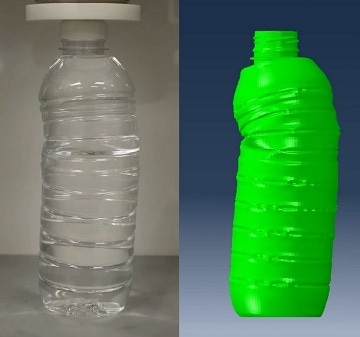Optimizing the top/squeeze load performance of oval containers
Computer simulation maximizes the real-world performance of squeezable, plastic oval containers used for many food and household cleaning products, according to an exclusive study.

Many food items and household cleaning products are often packaged in oval-shaped containers that dispense their contents by being squeezed. However, some of these containers can result in dispensing frustration and shelf-presence issues. According to a recent study by Plastic Technologies, Inc. (PTI), computer simulation to optimize performance criteria can provide solutions.
 Non-optimal stacking, coupled with excessively thin container corners, can create dents. Frequently, this is enough to deter the consumer from purchasing. Typically, a wide-label panel area is preferred for boldly displaying the product’s brand identity and its numerous marketing attributes but it does not necessarily result in optimum dispensing or ergonomics. In reality, a wide, flat-paneled container is frequently the most challenging to blow mold, needing specialized equipment and is most prone to denting and buckling.
Non-optimal stacking, coupled with excessively thin container corners, can create dents. Frequently, this is enough to deter the consumer from purchasing. Typically, a wide-label panel area is preferred for boldly displaying the product’s brand identity and its numerous marketing attributes but it does not necessarily result in optimum dispensing or ergonomics. In reality, a wide, flat-paneled container is frequently the most challenging to blow mold, needing specialized equipment and is most prone to denting and buckling.
To help understand which attributes make containers easier or harder to dispense, PTI tracked the force needed to dispense, along with the amount dispensed per millimeter of indentation, for a variety of 20- to 25-ounce containers in different product categories. To make the comparisons fair, same size containers in a similar market segment were analyzed.
Learn more about packaging and plastics at WestPack and PLASTEC West in Anaheim, CA, February 6-8, 2018. The venue includes free educational presentations, hands-on demos, networking opportunities, expert-led Innovation Tours and of course hundreds of exhibitors. For more information, visit the WestPack website. |
This study showed that most of the containers in the same size range (with widely-differing geometry) have similar weights, barring a few outliers. However, there is significant interplay between container grip region geometry, thickness distribution and squeeze performance. There likely exists an optimal cross section and thickness distribution for each geometry envelope that can maximize the performance of both top load and squeeze load.
Further there is the possibility of light weighting the container by changing shoulder angle, container aspect ratio and grip geometry. This is evident in higher top load strength found in larger-volume long neck containers.
The study concluded that computer simulations can be used to optimize performance criteria. Further, the virtual space offers significant potential to identify other critical parameters that drive consumer satisfaction such as ergonomics, easy pouring and bottle stability. (To download the full white paper, Squeeze Performance of Oval Containers, please visit PTI’s website.)
Author: Sumit Mukherjee is the Vice President, Advanced Engineering Services, Plastic Technologies, Inc. He has more than 23 years of experience in preform and container design, materials characterization, process simulation and modeling, and finite element analysis (FEA) for package performance prediction.
About Plastic Technologies
Plastic Technologies, Inc. (PTI) is recognized worldwide as a preferred source for preform and package design, package development, rapid prototyping, pre-production prototyping, and material evaluation engineering for the plastic packaging industry. For more information: www.plastictechnologies.com, [email protected] and 419-867-5424.
About the Author(s)
You May Also Like




